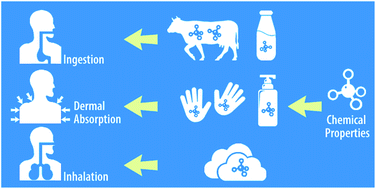Emerging investigator series: the role of chemical properties in human exposure to environmental chemicals
Abstract
One of the ultimate goals of environmental exposure science is to mechanistically understand how chemical properties and human behavior interactively determine human exposure to the wide spectrum of chemicals present in the environment. This comprehensive review assembles state-of-the-art knowledge of the role of partitioning, dissociation, mass transfer, and reactive properties in human contact with and absorption of organic chemicals via oral, dermal, and respiratory routes. Existing studies have revealed that chemicals with different properties vary greatly in mass distribution and occurrence among multiple exposure media, resulting in distinct patterns of human intake from the environment. On the other hand, these chemicals encounter different levels of resistance in the passage of intestinal, dermal, and pulmonary absorption barriers and demonstrate different levels of bioavailability, due to the selectivity of biochemical, anatomical and physiological structures of these absorption barriers. Moving forward, the research community needs to gain more in-depth mechanistic insights into the complex processes in human exposure, advance the technique to better characterize and predict chemical properties, generate and leverage experimental data for a more diverse range of chemicals, and describe better the interactions between chemical properties and human behavior.

- This article is part of the themed collections: Emerging Investigator Series and Best Papers 2021 - Environmental Science: Processes & Impacts


 Please wait while we load your content...
Please wait while we load your content...